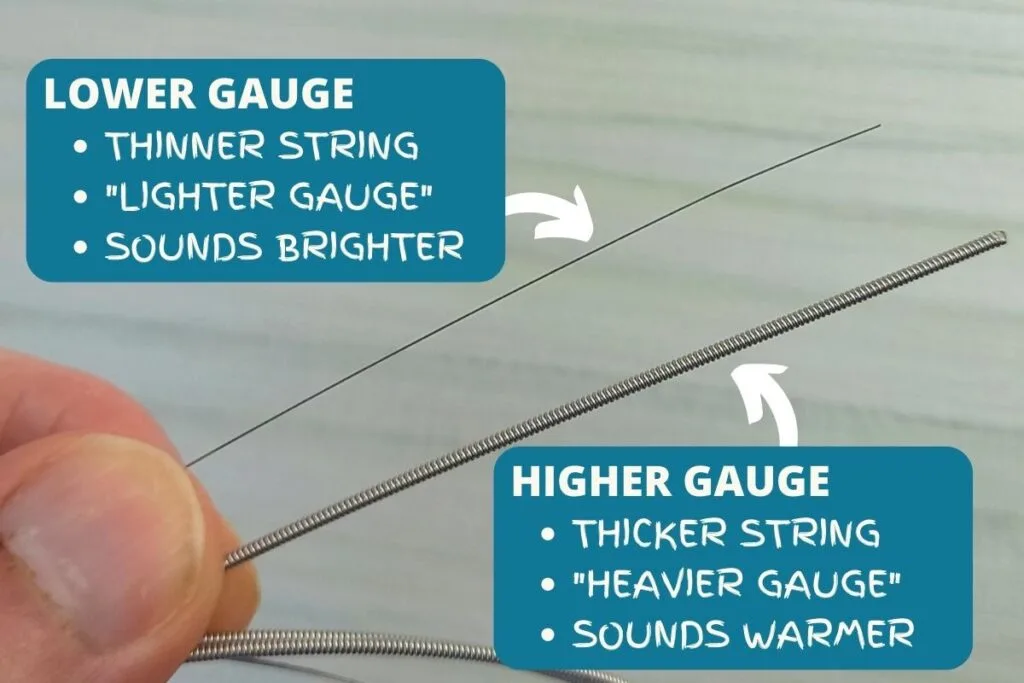Snapping a string on your acoustic guitar is annoying, and it’s even worse if you don’t have the right string to replace it! But, what if you had some electric guitar strings laying around – could you replace it with one of those?
I decided to find out by replacing all the strings on my acoustic guitar with electric guitar strings.
I found that electric guitar strings of a like-for-like string gauge work well on an acoustic guitar. They sound brighter and snappier. However, electric guitar strings are often thinner than acoustic guitar strings, which will cause them to sound quieter or unbalanced. Thinner strings can also cause problems with your acoustic guitar longer term, such as creating grooves in the nut slot or saddle.
Can you use electric guitar strings on an acoustic guitar?
If you’ve snapped a string on your acoustic, and only have electric guitar strings laying around, then you can use them on your acoustic guitar.
I tried it out myself by restringing my acoustic guitar with a set of Ernie Ball “Not Even Slinky’s” – and it worked. It feels odd (forbidden even!) but electric guitar strings do work on an acoustic.

The key thing here is that I replaced all the strings with strings of the same thickness. Generally, electric guitar strings are much thinner than acoustic strings.
In this case, you should only use thinner electric guitar string on an acoustic if you don’t have another alternative – and only for a short period of time. Why? Because longer term use can cause problems with your guitar.
String gauge
One of the biggest differences between acoustic and electric guitar strings is their string gauge – or how thick the strings are.
Acoustic guitar strings are, on average, much thicker than electric guitar strings. Thicker strings means more power, and acoustic guitars need powerful strings to give it plenty of volume.
Thinner strings, on the other hand, sound weaker in comparison. Electric guitars can get away with it, as they use guitar pickups to amplify the sound.
In my experience, most acoustic guitars come with gauge 12 strings as standard, and most electric guitars use gauge 10 strings. The electric guitar strings I used on my acoustic guitar were gauge 12 (which is thick for an electric guitar, but great for drop tuning!)

Using thinner strings on an acoustic will result in a quieter sound, which isn’t ideal. This is doubly true if you’re only replacing one string. In that case, it’ll mean that only one string will be quieter than the others, which would create a weird, unbalanced sound.
Not only this, but thinner strings are more likely to break. So if you’re a heavy strummer, then you risk snapping them. Then you’ll need to buy a new set anyway!
More serious, however, is the risk that thinner strings can damage your acoustic guitar. According to Sweetwater, thinner strings can eventually create grooves on the nut and saddle of your acoustic guitar that can cause intonation and tuning problems.
So, probably best to just wait and pick up some acoustic strings!
String tension
String tension goes hand-in-hand with string gauge. Thicker strings means more string tension. Thinner strings, less.
In addition to a weaker sound, a lower string tension can cause playing problems like fret buzz or dead notes. This irritating ringing sound can easily ruin any performance, and will be especially clean on an acoustic guitar.
I wanted to demonstrate just how different the strings tension is between acoustic and electric strings. So, I used publicly available data from D’Addario’s website to compare the string tension of a set of their gauge 10 electric guitar strings against gauge 12 acoustic guitar strings.
Straight off the bat, it’s telling how strong acoustic guitar strings are considering the electric guitar strings are advertised as “regular” whereas the thicker acoustic strings are packaged as “light”!
Here’s how they stack up:
| String | Average acoustic guitar strings tension (lbs) | Average electric guitar strings tension (lbs) |
|---|---|---|
| e | 23.37 | 16.22 |
| B | 23.30 | 16.60 |
| G | 29.25 | 16.53 |
| D | 29.01 | 17.21 |
| A | 27.47 | 17.21 |
| E | 24.03 | 16.91 |
| Total pressure | 156.43 | 100.68 |
As you can see, the acoustic strings apply around 64% more pounds of pressure than the electric strings. You can see that switching out any acoustic string with a lighter electric string is going to give you much less tension.
How do they sound?
When I restrung my acoustic guitar with electric guitar strings, I noticed that it sounded much brighter and snappier compared to regular acoustic strings.
The bass strings felt more responsive, and the unwound G string added some extra clarity to chords. I find that my acoustic guitar can sound a bit muddy at times, but the electric guitar strings really bought out some bright, shiny character.
As I’ve mentioned, however, electric guitar strings are most often lighter than acoustic strings. Using lighter strings will result in a quieter guitar and risks issues like fret buzz – if the guitar hasn’t been set-up to handle the new strings.
Comparing like-for-like thicknesses: electric and acoustic guitar strings will sound different as they’re made from different materials.
Material differences
To properly understand the differences, you need to know that there’s two types of guitar string – wound and plain. The plain strings are the three higher pitched strings and are made of a solid piece of steel. The wound strings (lower pitched), have a steel core but are wrapped in a layer of nickel.
This is the same for both acoustic and electric guitars. Typically, both acoustic and electric strings use steel for the string cores and plain strings. It actually says on the strings I used that you can use them for electric or acoustic.

The main difference comes from the material used for the wound strings. Acoustic guitars are commonly wound with 80/20 bronze, whereas electric guitar strings tend to be wound with nickel.
Bronze tends to sound warmer than nickel, which gives acoustic guitars their nice, warm, bottom end. Swapping one of these wound strings out with a nickel string will sound much brighter and punchier.
The plain strings, however, are the same. So, swapping out a plain acoustic string with an electric string of the same thickness will sound the same!
Final thoughts
If you need to restring your acoustic guitar, but only have electric guitar strings – then you can use them if you can’t afford to wait.
If they’re a similar string gauge then your acoustic strings, then there shouldn’t be a problem. But, if the strings are thinner than it can also cause wear to the nuts and saddle in the longer term.
Where possible, I recommend waiting and picking up a set of acoustic guitar strings. It’s important to use a balanced set of guitar strings to maintain the proper tension on your strings and avoid problems like fret buzz or dead frets. It’s also an important part of maintaining an even, balanced sound,
If you like the sound of electric guitar strings on an acoustic, I’d recommend just picking up a set of nickel wound acoustic guitar strings. You’ll get the bright, punchy sound without having to worry about whether it’ll damage your guitar!

Conor is a music producer, multi-instrumentalist, and all-round enthusiast from the UK with over 15 years of experience. He’s the founder and sole-content creator for the roundtable audio blog and YouTube channel.
